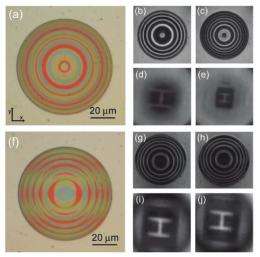October 11, 2011 feature
Nanowire lens can reconfigure its imaging properties

(PhysOrg.com) -- By taking advantage of the unique optical properties of nanoscale materials, researchers have designed a lens made of nanowires that can reconfigure its imaging properties without any electronic or mechanical control. The lens comes in two different varieties, one of which can enable zooming at two different magnifications, while the other can create stereoscopic images that show objects in three dimensions with a single, undivided lens. These functionalities could prove useful for micro imaging systems, which operate on a scale at which traditional zooming and stereoscopic imaging techniques do not work.
The researchers, Ethan Schonbrun, Kwanyong Seo, and Kenneth B. Crozier of Harvard University have published their study on the two new reconfigurable imaging systems in a recent issue of Nano Letters.
To build each lens, the researchers used nanowires with elliptical, rather than the usual spherical, cross-sections. In order to make the nanowires elliptical, the researchers used a combination of electron beam lithography and reactive ion etching to shape each nanowire. The elliptical nanowires exhibited an appealing effect called “form birefringence,” which means that information (or in this case, lens functions) can be holographically encoded into optical elements by changing the polarization of incoming light. Using this effect, the researchers could encode two different lens settings into each nanowire array lens.
“We have developed a method to encode two distinct lens functions into a single optical element,” Schonbrun told PhysOrg.com. “The encoding is based on the polarization-dependent response of elliptical cross-section silicon nanowires.”
The first nanowire array lens has the ability to magnify an object at two different magnifications (1.12 and 0.59), since the two different light polarizations determine the lens’ focal length. In this way, the lens serves as the front end of a non-mechanical zoom system for small objects located a few hundred micrometers away.
The second nanowire array lens has the ability to record three-dimensional stereoscopic images, a feat that usually requires two lenses positioned at different angles or at least a single lens with a divided aperture. In this lens, the focal length is the same for both polarizations of light, but the optical axis of each lens changes slightly depending on the polarization of incoming light. The resulting images have parallax, as if the lens had captured images of the objects from two different angles, even though the lens itself does not move and does not have a divided aperture.
In each of these lenses, the property in question (magnification and stereoscopy) can have one of two different settings. In the future, the researchers predict that it will be possible to increase this to three settings, although it will require increasing the number of different nanowire geometries.
These nano-sized lenses with reconfigurable properties could have applications in microoptical imaging systems, where it is traditionally difficult to dynamically adjust imaging properties. Small cameras are becoming increasingly used in medicine, such as for endoscopy, as well as in consumer photography and machine vision.
“This lens technology could be implemented in imaging applications that require few moving parts or reduced power consumption,” Schonbrun said. “In the future, we plan on integrating this lens technology with polarization diversity based image sensors to make these systems completely non-mechanical.”
More information: Ethan Schonbrun, et al. “Reconfigurable Imaging Systems Using Elliptical Nanowires.” Nano Letters. DOI:10.1021/nl202324s
Copyright 2011 PhysOrg.com.
All rights reserved. This material may not be published, broadcast, rewritten or redistributed in whole or part without the express written permission of PhysOrg.com.

















